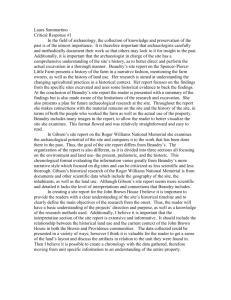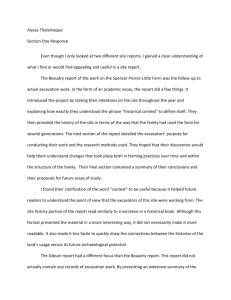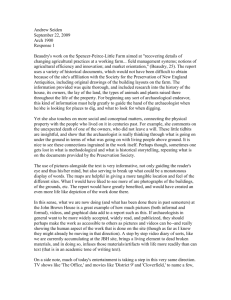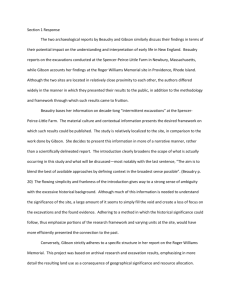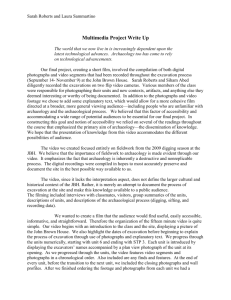BakerReponse1
advertisement
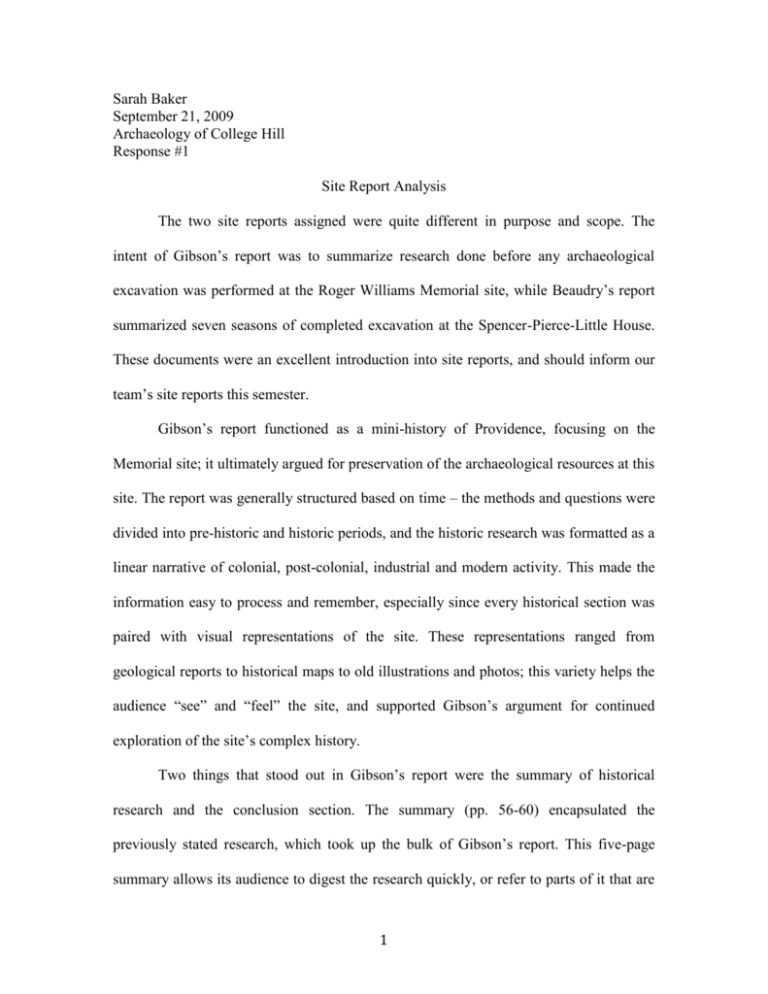
Sarah Baker September 21, 2009 Archaeology of College Hill Response #1 Site Report Analysis The two site reports assigned were quite different in purpose and scope. The intent of Gibson’s report was to summarize research done before any archaeological excavation was performed at the Roger Williams Memorial site, while Beaudry’s report summarized seven seasons of completed excavation at the Spencer-Pierce-Little House. These documents were an excellent introduction into site reports, and should inform our team’s site reports this semester. Gibson’s report functioned as a mini-history of Providence, focusing on the Memorial site; it ultimately argued for preservation of the archaeological resources at this site. The report was generally structured based on time – the methods and questions were divided into pre-historic and historic periods, and the historic research was formatted as a linear narrative of colonial, post-colonial, industrial and modern activity. This made the information easy to process and remember, especially since every historical section was paired with visual representations of the site. These representations ranged from geological reports to historical maps to old illustrations and photos; this variety helps the audience “see” and “feel” the site, and supported Gibson’s argument for continued exploration of the site’s complex history. Two things that stood out in Gibson’s report were the summary of historical research and the conclusion section. The summary (pp. 56-60) encapsulated the previously stated research, which took up the bulk of Gibson’s report. This five-page summary allows its audience to digest the research quickly, or refer to parts of it that are 1 especially interesting or relevant to the individual reader. It might have made more sense to put this summary at the beginning of this section, as it would let the reader know beforehand how the longer research section was structured. Secondly, the conclusions at the end of the report were crucial, as they summarized why the site is so important to preserve for future archaeological work. This report was structured like a scientific report, and, as such, the conclusions and argument came at the end. However, the report might have been stronger if it shared the argument first, and then presented the extensive research as support. Instead of opening the report by only stating the research questions (p. 1), it could have begun with an abstract containing the questions, a summary of the historical research, and a condensed version of the final arguments. Except for the brief history of the property’s line of ownership, Beaudry’s report was generally structured according to various subsites at the Spencer-Pierce-Little House; it explored the site by dividing it up into spaces, rather than examining the whole site over time, as Gibson did. Beaudry began her site report by sharing the broad questions guiding excavation, and then focused in on various subsites to address these questions. Researchers at the farmstead are interested in exploring land-use and changing agricultural practices in New England, and this overarching question helped frame the team’s research and their publication. Though it was less technical than Gibson’s report, Beaudry’s report also shares and explains the many methods used in research, including exploring local historical documents, interviewing local informants, field walking and excavation. 2 The guiding theme of Beaudry’s site report is the importance of viewing the site in ways that its past inhabitants might have viewed it. An 1812 farmstead survey divided the property into various sites near to the house and the extended fields that were part of the property. In accordance with these attitudes towards the land, the excavation and report are structured by discussing these sites separately, as divided up in the 1812 survey. This could inform our site reports at the John Brown House; for example, we already know that the orientation of the JBH was different when Benefit Street wasn’t the ‘main’ street by the property, and our current excavation locations reflect this knowledge. Two details that caught my eye in Beaudry’s report were the table detailing the list of owners, and the direct statements about unfinished and ongoing work. First, the table provided a clear timeline to refer to while reading the report. Tabular representation was very helpful here, and might even be improved if it was a graph, pictorially showing the lengths of ownerships of the property. Second, the author was direct in sharing what her teams are still working on; two examples are the extent of slave labor and treatment of slaves at the site, and examining material residue of women’s activities around the house. This highlighted that the work at the site is ongoing, and that the researchers aren’t jumping to any conclusions before they have appropriately examined the material evidence. This will certainly be the case with our reports at the JBH, as we are picking up an ongoing project, and have a limited amount of time to work. As stated above, there are a lot of details to take away from these two reports. We should frame central research questions, and use those questions to guide the format of our reports. Our team should consider where it is appropriate to use visual, graphic and tabular representation in the JBH reports. We should provide summaries of background 3 research, where appropriate, and be direct about unfinished work and unanswered questions at the end of the season. Since we are researching several time periods at different units, it may be hard to connect the units in our report. Perhaps we should summarize the history of the whole site, and then write about the units separately. Since we have limited workdays, we could frame these unit reports in terms of each day of excavation. Also, I really liked the idea of the object biographies from last year; looking at an object’s life, from use to deposition to excavation, through the “object’s eye”, so to speak, might be an interesting way to enter into researching what we find. Finally, framing a multimedia report as an online map, with clickable links to the units, various objects within the unit, photos, videos and daily documentation might be the most userfriendly way to present all of our information. 4
